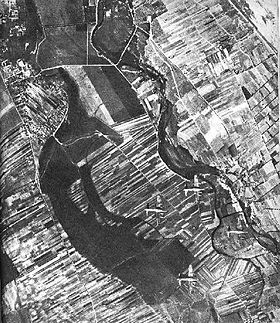| Warsaw airlift | |||||||
|---|---|---|---|---|---|---|---|
| Part of / In support of "Operation Tempest", World War II | |||||||
 American Boeing B-17 Flying Fortress aircraft leaving Warsaw and heading East after air drops on September 18 (Wisła river visible as well as Wilanów Palace gardens in upper left part of image.). | |||||||
| |||||||
| Belligerents | |||||||
|
| |||||||
| Casualties and losses | |||||||
|
41 aircraft destroyed 360 aircrew killed | Unknown | ||||||
The Warsaw airlift or Warsaw air bridge[1] was a British-led operation to re-supply the besieged Polish resistance Home Army (AK) in the Warsaw Uprising against Nazi Germany during the Second World War, after nearby Soviet forces chose not to come to its aid. It took place between 4 August and 28 September 1944 and was conducted by Polish, British, Canadian, Australian, New Zealand and South African airmen flying from Celone and Brindisi in Italy and was denied flyover rights from their Soviet allies, who shot at them when the planes entered Soviet airspace. On 18 September, in the final stages of the Nazis crushing the uprising, one United States airdrop was launched from Great Britain and landed at Poltava in Soviet Ukraine as the distance to the drop-zone precluded the aircraft returning to base. The flights from Italy were night operations with low level cargo drops, conducted without fighter escort while the single United States Army Air Forces mission of 18 September 1944 was a high-altitude (and therefore largely inaccurate), daylight operation consisting of 107 B-17s protected by P-51 fighters. From the night of 13/14 September, Soviet aircraft flew some supply drops, dropping about 130 tons in total until 27/28 September. Initially, this cargo was dropped without parachutes, resulting in much of the payload being damaged or destroyed.
Allied aircraft dropped a total of 370 tons[Note 1] of supplies in the course of the two months of operations, of which at least 50% fell into German hands. The airlift proved to be ineffective and could not provide sufficient supplies to sustain the Polish resistance, who were overrun by Nazi forces on 2 October 1944. The airlift was further hampered by the Soviet Union not allowing Western Allies the use of its airfields for several weeks,[2] forcing flights to operate at extended ranges from Italy and Britain and in so doing, reducing payload and limiting the number of sorties. An estimated 360 airmen and 41 British, Polish, South African and American aircraft were lost.
- ^ "Jim Auton: Hundreds at funeral for WW2 Warsaw Air Bridge hero", BBC News, 6 February 2020
- ^ "Pincers (August 1944 – March 1945)". The World at War. Episode 19. 20 March 1974. 21 minutes in. ITV.
Stalin was very suspicious of the underground, but it was utterly cruel that he wouldn't even try to get supplies in. He refused to let our aeroplanes fly and try to drop supplies for several weeks. And that was a shock to all of us. I think it played a role in all our minds as to the heartlessness of the Russians. Averell Harriman U.S. Ambassador to Russia 1943-46
Cite error: There are <ref group=Note> tags on this page, but the references will not show without a {{reflist|group=Note}} template (see the help page).
© MMXXIII Rich X Search. We shall prevail. All rights reserved. Rich X Search
